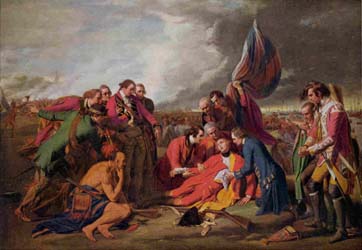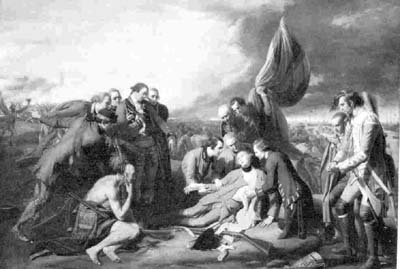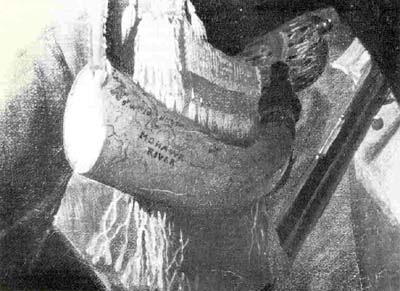
Bulletin 7 (IV:1), 1966
Home
Français
Introduction
History
Annual Index
Author &
Subject
Credits
Contact




Benjamin
West and 'The Death of Wolfe'
by Colonel C. P. Stacey, Director of History
Department of National Defence
Résumé en français
Pages 1 | 2 |
3
Benjamin West's The Death of Wolfe (Fig. 1) has been
called 'probably the most famous of all historical paintings' (1) - a
large statement but one that would be difficult to controvert.
It would be equally difficult, I think, to deny that as a
representation of an historical event it is among the worst ever
produced.
The basic facts about the painting can be briefly stated. West
exhibited it at the Royal Academy in 1771. The original picture was
purchased by Lord Grosvenor, whose descendant, the Second Duke of
Westminster, presented it to Canada, through Lord Beaverbrook, as a
tribute to what the Dominion had done in the First World War. This
is the canvas which hangs today in the National Gallery of Canada,
Ottawa. Subsequently, West is known to have painted three copies of
the picture: one for King George III, now in Kensington Palace,
London (Fig. 2); one for the Monckton family, now in the Sigmund
Samuel Collection, Toronto (Fig. 3); and one for the Prince of
Waldeck, which is now in the William L. Clements Library at Ann
Arbor, Michigan (2) (Fig. 4). Between the four versions there are
important variations, as the reproductions published here with make
clear.
It has often been said (notably in both the Dictionary of
National Biography and the Dictionary of American Biography) that
West was the first to abandon the Greek and Roman and introduce
modern costume into historical painting; and it appears that West
himself was responsible for circulating the story that Sir Joshua
Reynolds advised the King against buying the original Death of
Wolfe on the ground that this new-fangled idea would never
'take'. The King, we are assured, was displeased when he discovered
that it had in fact taken, and Lord Grosvenor had the picture; it
was then that he commissioned West to paint him a copy. (3) In fact,
the story that West was the first to use modern dress in painting
modern historical scenes has long been exploded; he was not even the
first to paint the death of Wolfe in this manner - it appears that
Romney did this seven years earlier (in a picture now lost) and
Edward Penny had done it at least twice, in pictures that may have
somewhat influenced West. (4)
West is reported to have justified the picture to King George with
the remark, 'the same truth that guides the pen of the historian
should govern the pencil of the artist'. (5) If he really said this,
he did not practise what he preached; for The Death of Wolfe is
a remarkably untruthful production. Almost everything about it is
historically wrong. Notably, of course, as a representation of the
actual individuals who were present when Wolfe died it is merely
grotesque. In the final stages of the Battle of the Plains of
Abraham the senior officers of Wolfe's army had other things to do
besides grouping themselves picturesquely about the dying general.
From 1759 onwards quite a number of people have investigated the
question of who actually were with Wolfe in his last moments; and
the consensus is that not more than four or possibly five persons
were present. In West's group there are 13; and of those of them who
can be identified with moderate certainty only one actually
seems to have been there. This is Lieut Henry Browne, who is said to
be the young officer standing directly above Wolfe and carrying the
flag. (6)
The group includes one of Wolfe's three brigadiers, the Hon. Robert
Monckton, who had been wounded and was being moved aboard a
frigate, (7) and certainly was not standing fixing a sad eye on
Wolfe. Monckton's presence in the picture however is perhaps the
only piece of genuine historical information it imparts. If Monckton
was willing to be painted in this pose, and if the Monckton family
were willing to commission West to paint a copy of the picture for
them, it argues that Monckton did not entertain seriously unfriendly
feelings towards Wolfe. (The other brigadiers, Townshend and Murray,
whose intense dislike of Wolfe is well documented, are
noticeably missing from the picture.) Also in the group is one
battalion commander, for the Highland officer appears to be Colonel
Simon Fraser of Fraser's Highlanders. (8) This regiment was heavily
engaged in the final phase of the battle and had many casualties;
and it is incredible that their colonel could have been occupied at
this time in striking attitudes in a rear area.
Another battalion commander is traditionally identified on the left
of the picture. The Marquess of Sligo wrote that this figure 'is
accepted by all as Sir William Howe', and another writer (9) speaks
of Howe wearing 'Indian dress'. However, the dress is not
Indian, and the person almost certainly is not Sir William Howe. The
dress is that of an American Ranger, as represented in the portraits
of Robert Rogers. And close inspection of the Ottawa picture reveals
on the officer's powder-horn a crude map (Fig. 5) including the
words 'sr. wm. Johnson' and 'Mohawk River'. (10) Johnson, one hastens
to add, was not at the Battle of the Plains;
his published correspondence proves that at the time he was at
Oswego. Nor, of course, was he a Ranger. Neither was Howe. This
figure was probably put in by West simply by way of local colour,
along with the Indian. Johnson was not in England when the picture
was being painted, and the face under the Ranger cap does not seem
to be a portrait of him.
The other people who are identified in the existing keys to the
picture can be briefly dealt with. The middle-aged officer close
behind Wolfe is said to be Isaac Barré, his adjutant general;
comparison with portraits of Barré seems to confirm this. (11) Alas
for historic truth, however: Barré was badly wounded in the face
during the battle; he would certainly have been in no condition to
mourn beside his chief as we see him doing here. Directly behind
Barré is a figure said to be that of 'Adam' Williamson, Wolfe's
artillery commander. This is probably an accurate identification,
for the uniform is that of a gunner officer; but Colonel
Williamson's Christian name was George. The young officer in the
exact centre of the picture, on Wolfe's right, is said to be one of
his aides-de-camp, Captain Hervey Smyth, who was himself something
of an artist; the National Gallery of Canada has two of his
paintings. I cannot say whether or not the portrait is that of
Smyth; but I can say that there is no evidence that either Smyth or
any other member of Wolfe's personal staff was with him when he
died. The officer supporting Monckton from behind is reputed to be
Captain-Lieutenant Hugh Debbieg, an infantry officer whom the Army
List shows as employed at this time as an engineer; the officer on
Monckton's left has been called 'Colonel Napier'. There does not
appear to have been any Napier at Quebec. West was perhaps capable
of including Major William Napier who appears in the contemporary
Army List in the 68th Foot-even though the 68th were in the Channel
Islands. But I suspect that this handsome, if somewhat horse-faced,
officer has never been accurately identified.
Next Page | The
surgeon at Wolfe's left
1 |
2 | 3
Annual Index | Author & Subject | Credits | Contact
This digital collection
was produced under contract to Canada's Digital Collections program,
Industry Canada.
"Digital
Collections Program, Copyright
© National Gallery of
Canada 2001"